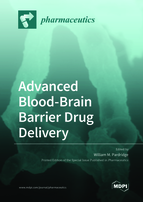Advanced Blood-Brain Barrier Drug Delivery
A special issue of Pharmaceutics (ISSN 1999-4923). This special issue belongs to the section "Drug Delivery and Controlled Release".
Deadline for manuscript submissions: closed (30 June 2022) | Viewed by 58052
Special Issue Editor
Special Issue Information
Dear Colleagues,
The aim of this Special Issue in Pharmaceutics is to highlight the latest developments in the field of blood-brain barrier (BBB) drug delivery. Articles will address the BBB drug delivery of small molecules via SLC and ABC transporters, as well as the BBB drug delivery of biologics via receptor-mediated transporters. Advances in BBB drug delivery science have led to the development of new treatments for CNS disease, including neurodegeneration, brain cancer, and genetic disease. Future innovation in BBB drug delivery requires knowledge on the proteomics and genomics of the brain microvasculature, which can lead to new transporter discovery, as well as an understanding of the regulation of the integrity of the BBB in health and disease. Advances in the methodology of BBB drug transport are reviewed for both in vitro models of BBB transport using stem cells, and in vivo physiologic-based models of drug transport across the BBB in vivo.
Prof. Dr. William M. Pardridge
Guest Editor
Manuscript Submission Information
Manuscripts should be submitted online at www.mdpi.com by registering and logging in to this website. Once you are registered, click here to go to the submission form. Manuscripts can be submitted until the deadline. All submissions that pass pre-check are peer-reviewed. Accepted papers will be published continuously in the journal (as soon as accepted) and will be listed together on the special issue website. Research articles, review articles as well as short communications are invited. For planned papers, a title and short abstract (about 100 words) can be sent to the Editorial Office for announcement on this website.
Submitted manuscripts should not have been published previously, nor be under consideration for publication elsewhere (except conference proceedings papers). All manuscripts are thoroughly refereed through a single-blind peer-review process. A guide for authors and other relevant information for submission of manuscripts is available on the Instructions for Authors page. Pharmaceutics is an international peer-reviewed open access monthly journal published by MDPI.
Please visit the Instructions for Authors page before submitting a manuscript. The Article Processing Charge (APC) for publication in this open access journal is 2900 CHF (Swiss Francs). Submitted papers should be well formatted and use good English. Authors may use MDPI's English editing service prior to publication or during author revisions.
Keywords
- blood-brain barrier (BBB)
- brain drug delivery
- SLC transporters
- receptor-mediated transport
- IgG fusion proteins







